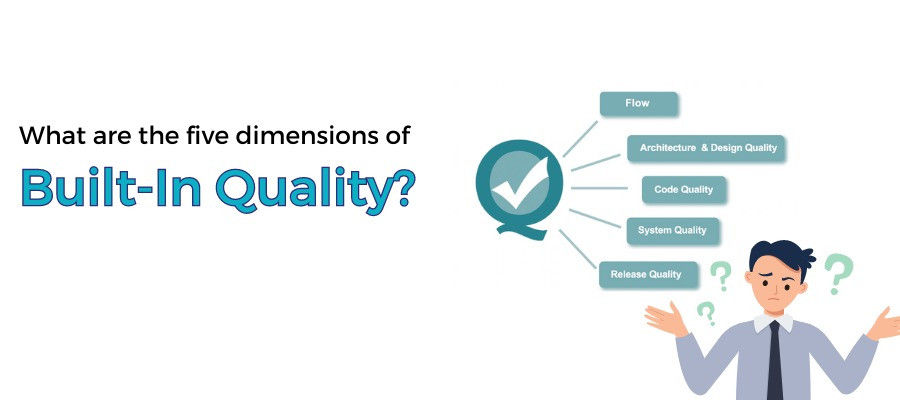What are the five dimensions of Built-In Quality?

The concept of built-in quality embodies the inherent level of excellence embedded within a product or service right from its inception. It encompasses meticulous design, engineering, and manufacturing processes to produce superior results.
Understanding and prioritizing built-in quality is paramount as it directly influences whether the product or service meets customer expectations, ensuring reliability and durability. Moreover, it significantly minimizes expenses associated with bug fixing, catching up, repairs, replacements, and customer service support.
Built-In Quality: Origins and Significance Across Industries
The concept of built-in quality originated in the manufacturing industry, where it referred to integrating quality considerations into product design and production processes. Unlike traditional quality control methods focusing on inspecting and identifying defects in finished products, built-in quality emphasizes the proactive approach of preventing defects and ensuring product excellence.
Built-in quality recognizes that the quality of a product is primarily determined by the design and production processes rather than relying solely on post-production inspections or customer feedback. By incorporating quality measures at every stage of development, organizations aim to minimize defects, enhance customer satisfaction, and reduce costs associated with rework or recall.
Over time, the principle of built-in quality has transcended the manufacturing industry and found relevance in various sectors, including software development, construction, healthcare, and services. Regardless of the industry, the core idea remains: prioritize quality from the outset by implementing robust processes, standards, and methodologies to create superior products or deliver exceptional services.
Integrating Quality at Every Stage: The Key to Successful Software Development in SAFe®
In the Scaled Agile Framework (SAFe®) context, built-in quality revolves around the seamless integration of quality considerations throughout the entire software development lifecycle. By embedding quality practices from requirements gathering to deployment, SAFe® aims to deliver software products that meet customer needs and are devoid of defects. This comprehensive approach emphasizes continuous improvement, collaboration, and the integration of quality measures at every step of the development process.
SAFe® underscores the significance of built-in quality by advocating for continuous integration and testing. Additionally, it incorporates quality gates to ensure that only high-quality code is deployed to production, thereby fostering a focus on delivering exceptional software products.
Built-in quality assumes a pivotal role within the SAFe® framework as it ensures that software development prioritizes quality and customer satisfaction, ultimately resulting in a more prosperous outcome for the development team and the overall business.
SAFe®’s Five Dimensions of Built-In Quality
1. Flow: Maximizing Efficiency from Concept to Delivery
The flow dimension in SAFe® emphasizes seamless and efficient work movement throughout the software development process. It focuses on optimizing speed, reducing waste, and eliminating bottlenecks. By ensuring a smooth flow of work, organizations can deliver software systems that meet user requirements, are completed on time, and stay within budget.
2. Architecture and Design Quality: Establishing a Solid Foundation
The architecture and design quality dimension highlights the importance of a well-structured and thoughtfully designed software system. This includes code organization, algorithm selection, and technology appropriateness. By emphasizing sound architecture and design, organizations can develop software systems that are easily understandable, maintainable, extensible, and aligned with user needs.
3. Code Quality: Crafting Reliable and Scalable Solutions
The code quality dimension pertains to the intrinsic quality of the code itself. It encompasses attributes like readability, maintainability, and scalability. Prioritizing code quality enables the creation of software systems that are reliable, efficient, and easy to comprehend, ensuring they meet user expectations.
4. System Quality: Performance and Reliability at the Core
The system quality dimension focuses on the overall performance and reliability of the software system. It encompasses stability, scalability, efficiency, and handling unexpected scenarios. By upholding system quality, organizations can develop software systems that are dependable, efficient, and meet user requirements effectively.
5. Release Quality: Delivering Excellence to Users
The release quality dimension encompasses the final software delivery stage to end users. It emphasizes stability, reliability, overall performance, and customer satisfaction. By prioritizing release quality, organizations can ensure that software systems meet user needs, are delivered punctually, and elicit high joy.
By attending to these five dimensions, organizations can enhance the built-in quality of their software products, resulting in greater customer satisfaction, improved efficiency, and increased business success.
Wrapping up
Built-in quality is a foundational concept that originated in the manufacturing industry and has since gained significance across various sectors. It emphasizes the integration of quality considerations into the design, development, and production processes to create superior products or deliver exceptional services.
In software development, built-in quality is crucial within the Scaled Agile Framework (SAFe®). SAFe® emphasizes five critical dimensions of built-in quality: flow, architecture and design quality, code quality, system quality, and release rate. Organizations can optimize efficiency, establish a solid foundation, craft reliable solutions, ensure performance and reliability, and deliver excellence to end-users by addressing each size.
Reference
- https://learningloop.io/glossary/built-in-quality



